SACRAMENTO, Calif. — If you've taken a DNA test to learn more about your ancestry, you might want to check your results again.
A new 23andMe update this month has changed some customers' results.
This comes as DNA testing companies work to improve a deficiency that makes some people's results less accurate and less specific than others, depending on where their ancestors are from.
When you spit into a tube and send it to the testing company, your DNA is compared to a pool of people with known ancestry, called a reference population. It’s like the control group — and your DNA is the variable.
“It’s looking at — ‘Who are you genetically similar to?’” said Dr. Graham Coop, a human evolutionary geneticist and UC Davis professor.
The specificity and accuracy of someone’s results boil down to the testing company’s reference population, he said.
“If a particular area of the world they don't have a lot of reference individuals from, you won't actually be able to tell whether someone is from that area of the world,” Coop said. “Areas which are better covered in their databases, they'll have more granular information about ancestry.”
FOLLOW To The Point:
► Follow Alex on Facebook and Instagram
► See all of To The Point stories
► Watch To The Point with Alex Bell every weekday night from 6:30 - 7 p.m.
TESTING THE TESTS
For months now, ABC10 has been following two local women's journeys of discovery, as they experienced this deficiency firsthand. Both women had already taken a 23andMe test — and each agreed to take a different company’s test, to compare the results. The process revealed unexpected information.
Catalina Delapeña lives in Sacramento when she’s not attending college in New York. She took the 23andMe DNA test last year.
“I was just kind of expecting…I was going to be Chinese,” Delapeña said. “I probably thought maybe I'd have like, oh, 15% Korean.”
Adopted as a baby from an orphanage in Wuzhou, China, she hoped the results would give her information about the biological family and past she’s never known.
“Most people…they know their birth story, they know how they came to be,” Delapeña said. “The one thing that I'll probably always think about for the rest of my life is my birth parents and where they are now or if they think about me ever.”
In the same breath, she added about the couple who adopted her: “My two moms are my real parents. It's just not even a question.”

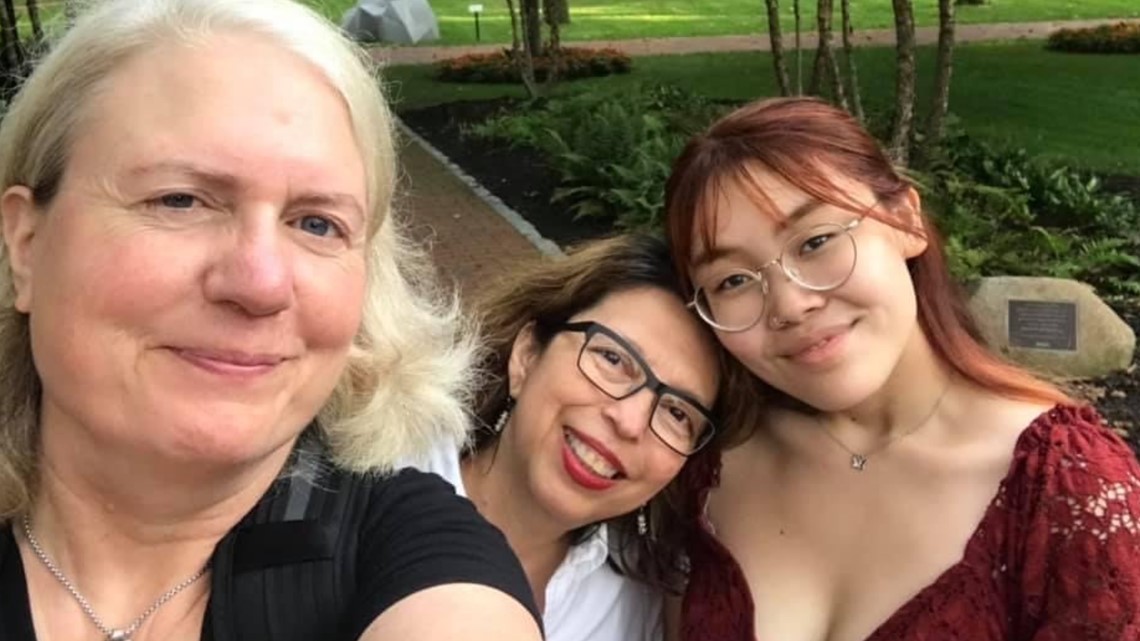
What she learned when she got her 23andMe results back, however, rocked her sense of identity.
“The results were so insane. I really wasn't expecting it at all,” she said. “It said I was 85% Vietnamese and then 15% different parts of, like, Chinese… I was like, ‘Oh, my God, I don't even know anything about being Vietnamese.’”


She documented her feelings for a college project she named—The Death of my Chinese Self (and Rebirth).
“I already felt like a fraud almost in my culture already. I couldn't really connect to my Chinese heritage at all growing up, especially growing up in the Midwest [where] it was very white,” Delapeña said. “When I got the test results back, it felt like the death of my culture all over again. I think I'm still kind of trying to process what that means to me.”
Justien Balarie, of Rocklin, took the 23andMe test two years ago.
“My mom is Vietnamese 100%, and my dad is 100% Japanese, to our knowledge, so it should be somewhere, roughly, 50/50,’” she said, reflecting on her expectations before getting the results.

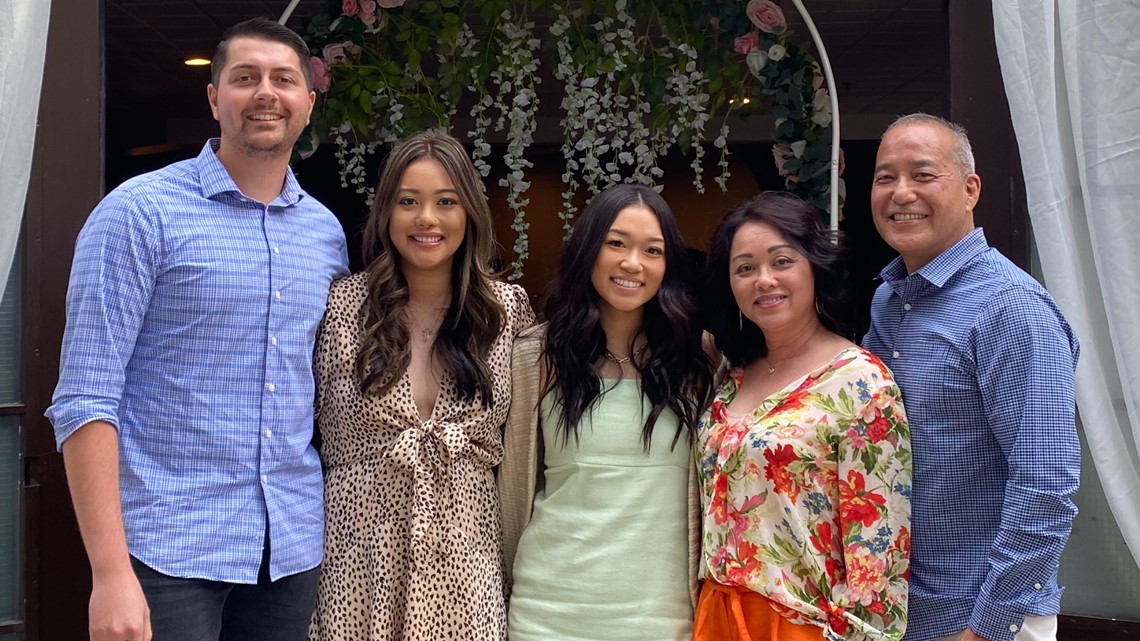
Balarie also got a surprise. 23andMe said she was 50% Vietnamese, as expected, but only 41.5% Japanese.
“And then there was this…8%, like, Filipino!” Balarie said. “It was interesting because a lot of people…they ask if I'm Filipino. And I'm just like, ‘No, I'm not. I'm half-Vietnamese, half-Japanese.’ But, like, I guess I am!”
Now that Balarie and her husband are expecting their first child, this family history is knowledge they can pass along to their daughter.
“I'm very proud to be Japanese and Vietnamese,” Balarie said. “To me, adding another country in there for me was exciting, personally. Like, ‘Yeah, I'm Filipino, too!’”

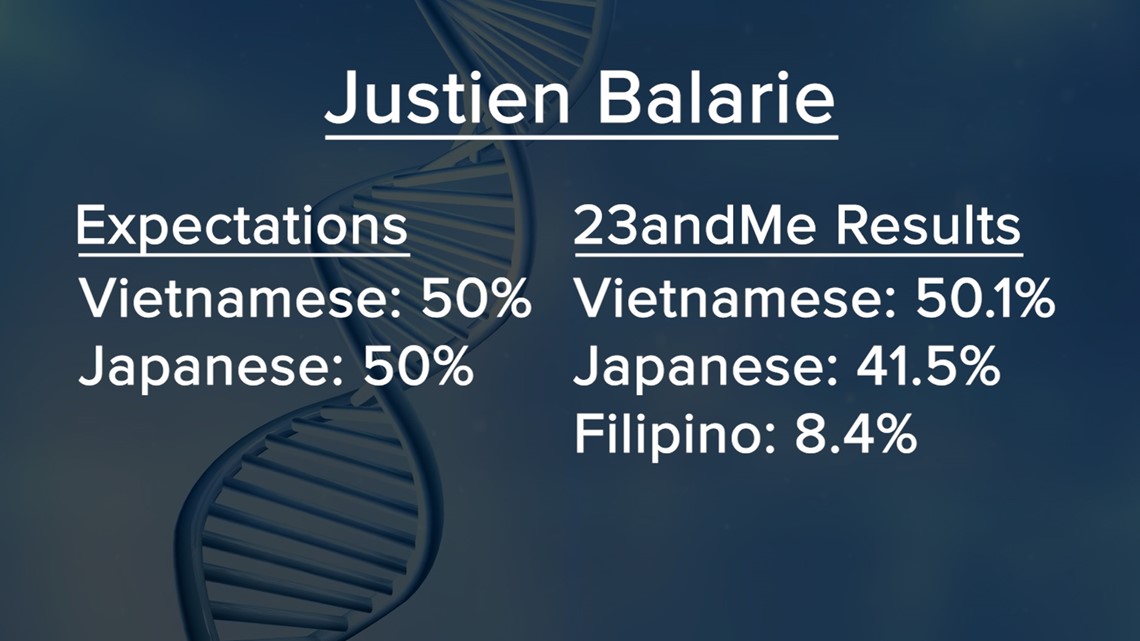
COMPARING RESULTS
Knowing, as UC Davis’ Professor Coop said, that the accuracy and specificity of someone’s results depend on a DNA testing company’s reference population — and that each company has its own reference population — ABC10 asked Delapeña and Balarie if they’d like to test with AncestryDNA and compare those results to the ones from 23andMe.
“I would be interested to see if that [Filipino ancestry] show[s] up as well,” Balarie said.
Both women took the second test, spitting into a tube provided in the AncestryDNA test kit and sending that into the company’s lab. Results came back in less than a month.
Delapeña’s AncestryDNA results were significantly different than her 23andMe results, saying she was 56% Vietnamese (compared to 23andMe’s assessment of 85%) and 44% Chinese (compared to 15%).
“My first thought immediately is, I'm less Vietnamese than I originally thought,” Delapeña said, adding that going from 85% Vietnamese to nearly half-and-half is “a lot to process.”

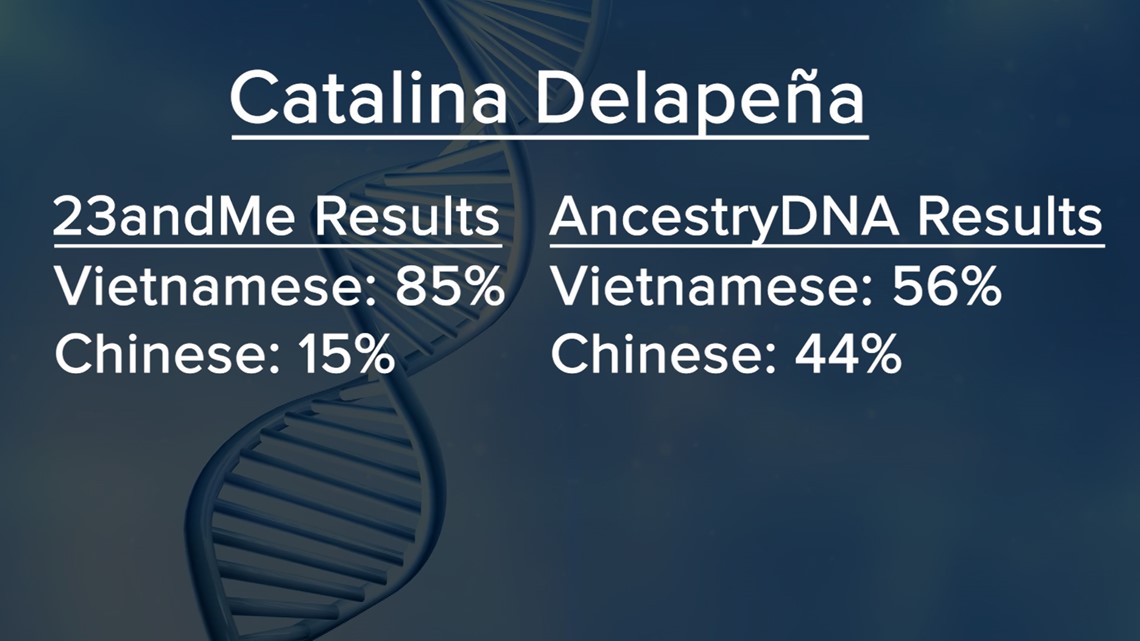
Balarie’s AncestryDNA test results included a total surprise.
Both tests had similar estimates for her Japanese genetic makeup. AncestryDNA put that at 44% and 23andMe put it at 41.5%.
Both tests showed Filipino ancestry. AncestryDNA put that at 10%, compared to 23andMe’s 8.4%
There was a sharp difference in her Vietnamese estimations. AncestryDNA said that only made up 30% of her genetics, whereas 23andMe told her it was 50.1%.
The real surprise came in an ethnicity that Balarie said had never been on her or her parents’ radar: Chinese. AncestryDNA said she was 13% Southern China and 2% Chinese Dai. 23andMe results showed no Chinese ancestry.
"Does that make me Chinese, too? So I'm Japanese, Vietnamese, Chinese, Filipino. That's a lot of things I didn't know I was!” Balarie said. “The whole being Filipino was shocking, when I found that out, so now that adding in Chinese-- that's even more shocking.”

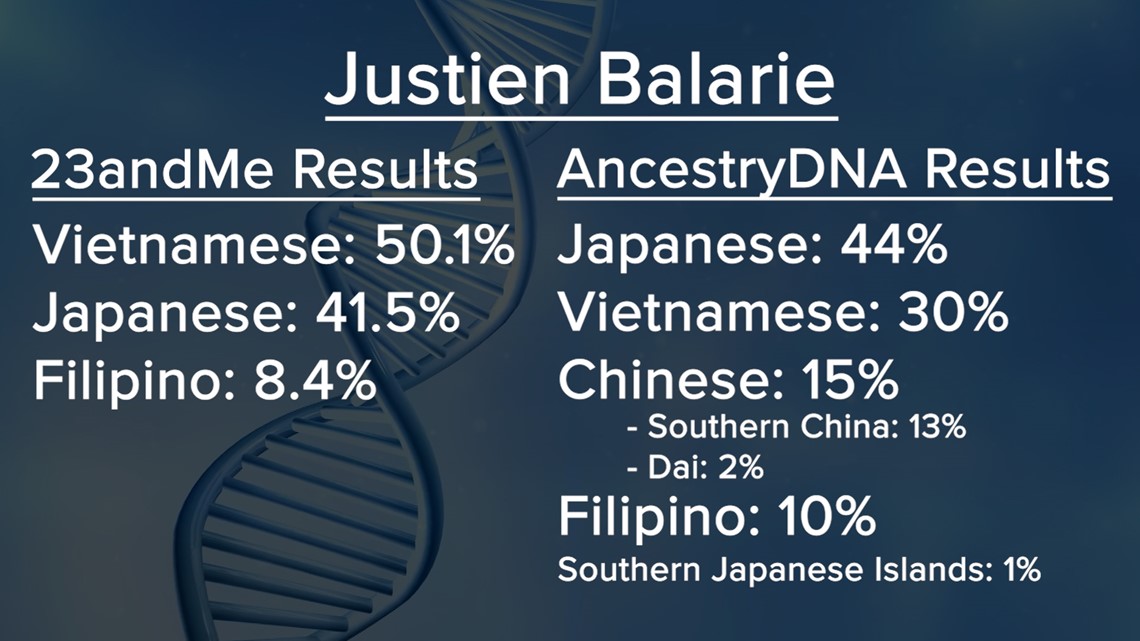
ASKING THE EXPERTS
ABC10 reached out to 23andMe and AncestryDNA to ask about each woman’s differing results.
23andMe connected ABC10 with one of their product scientists, Sam Ancona Esselmann, for a zoom interview.
“These are estimates based on reference populations, and those reference populations are typically different from one company to the next,” she explained.
AncestryDNA declined to make someone available for an interview, opting instead to send a statement:
“Ancestry has the world’s largest consumer DNA network with more than 22 million people and we’re always working to diversity our database. In June 2022, we more than doubled the number of markets where AncestryDNA is available for purchase. With this expansion, we now reach the rest of North America, additional locations in South America, Europe and Asia, and established our presence in South Africa. We continuously update our algorithm and reference panel, which may change some users’ results over time. As we add more customers to our AncestryDNA database, we aim to increase the number of ethnicity regions and the granularity of insights for all users regardless of their background.”
23andMe's Ancona Esselmann said people with ancestry traceable to island nations — like Japan and the Philippines — tend to be easier to pinpoint.
“A population that's lived on an island for centuries or millennia, typically, is going to be a lot easier to kind of identify as a distinct population, just because of that geographic isolation, than a population that, you know, maybe is in the middle of a continent and has had a lot of kind of migration going through it,” Ancona Esselmann explained.
Because of extensive migration, she said, China proved more of a challenge for 23andMe scientists.
“China, we knew that there was work to be done,” she said.
So, 23andMe scientists drilled down into a recent study and — just earlier this month — rolled out an update with more specific genetic populations within China.
That update changed Delapeña’s original results.
“The updated results from 23andMe are more similar to my original AncestryDNA results,” she said.
Instead of 85% Vietnamese, as 23andMe originally reported, Delapeña’s updated 23andMe results now show 63% Vietnamese. Instead of the original estimate of 15% Chinese, the updated results show 36.7% Chinese — including 21.5% from the southern Chinese province of Guangxi. (The remaining 0.4% is listed as “Broadly East Asian.”)

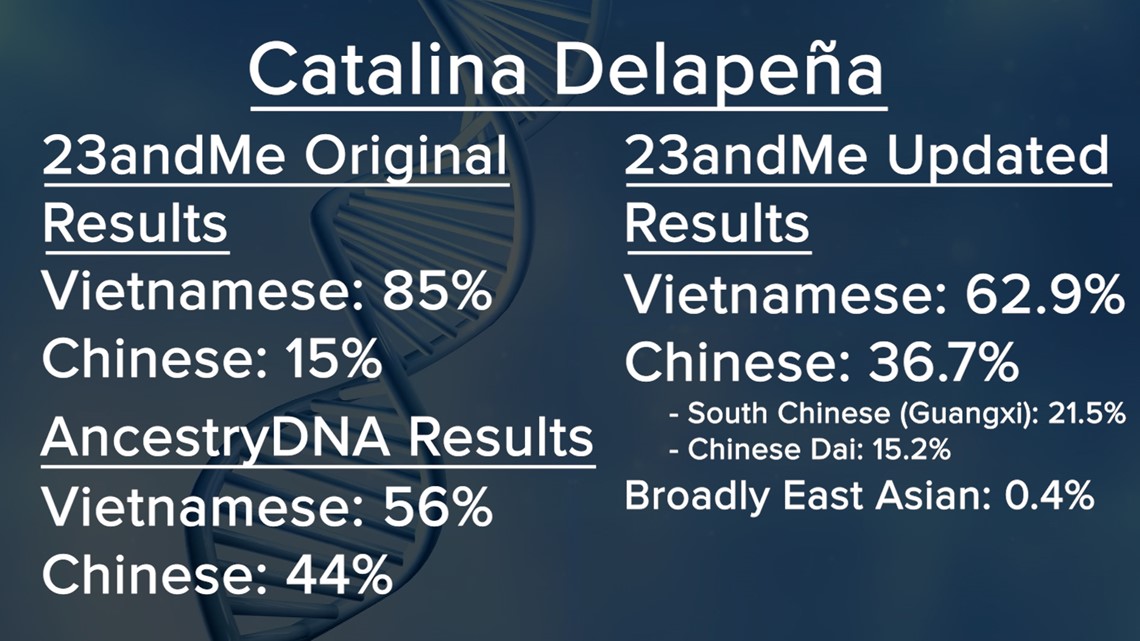
Delapeña let us share this with 23andMe’s scientist.
“That’s pretty cool to see she has that really specific ancestry,” Ancona Esselmann said. “Guangxi is actually closer to Vietnam and kind of, historically, might have a little bit more of that shared genetic ancestry with Vietnam even than other parts of that southernmost Chinese region. So pretty cool to see that.”
We took Ancona Esselmann’s answers back to Delapeña.
“The update that 23andMe has done is really great,” she said. “It's really interesting how reference populations can really just affect your results.”
She reflected on the fact that the 23andMe results that first rocked her sense of identity — “like the death of my culture all over again,” as she put it — now, with this new update, more closely resemble the results from the second, AncestryDNA test she took.
“It'd be great to get more accurate results on the first time,” she said. “But I'm really grateful for that because it has helped me realize that identity is something that everyone, you know, struggles with, and it's something that's very fluid and it can be always changing.”
She’s on a self-journey of discovery that goes beyond genetics.
UPDATE: Delapeña reached out to ABC10 three days after this story was published to share that her AncestryDNA results had just updated.
"New results! Vietnamese went from 56% to 68%," she said, calling it "pretty crazy."
Her AncestryDNA results now more closely resemble the updated 23andMe results.

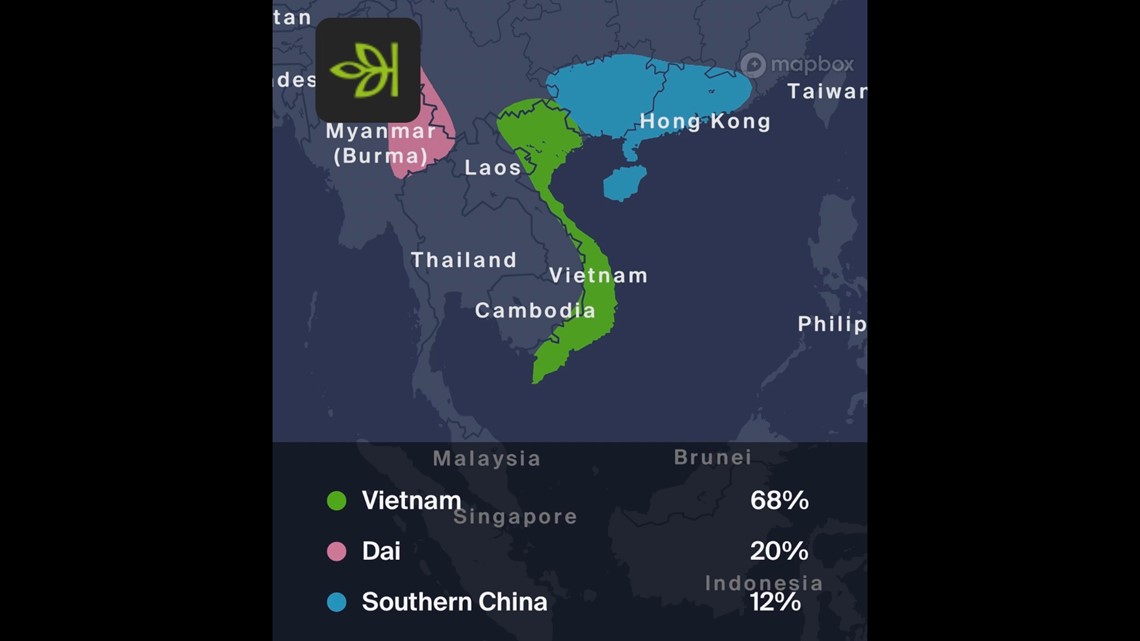
NOTE: Catalina Delapeña is the daughter of ABC10’s Director of Content Jill Manuel and Justien Balarie is an employee of ABC10. Each woman shared her journey of discovery for this story in order to both learn more about her own genetic ancestry and also hopefully help shed light on the process for others.
CHECKING YOUR RESULTS
23andMe and AncestryDNA encourage customers to periodically revisit their results, which can change over time as the companies grow and diversify their respective reference populations, consequently adding accuracy and specificity to their ability to analyze someone’s DNA.
There are other DNA testing companies to choose from, including FamilyTreeDNA, MyHeritage, and LivingDNA.
The National Library of Medicine has helpful tips on how to choose a reputable DNA testing company and what to know before deciding to test. One has to consider how much genetic data they’re comfortable giving to a company — and each company has its own privacy policy.
As one 2018 article on Johns Hopkins Medicine's website puts it, "some genetic testing companies sell the information they gather to third parties, primarily for research. And with a court order, the information can be obtained for detective work."
Also, as AncestryDNA says on its website, “you may discover unexpected facts about yourself or your family when using our services. Once discoveries are made, we can’t undo them.”
23andMe says, “some people are excited about these new connections and others take more time to integrate this information into their sense of self.”
Ultimately, Professor Coop advised, to take DNA test results “with a grain of salt. See if they sort of check out with what you know about your own family history. They're useful predictions. They're interesting, you know, trivia about yourselves, but you shouldn't invest too much in them…Who you're closely related to, genetically, is only a small part of who you are and how you identify. It shouldn't sort of radically alter how you perceive yourself.”
WHO IS UNDER-REPRESENTED IN REFERENCE POPULATIONS? AND WHAT’S BEING DONE TO FIX THAT?
As Ancona Esselmann explains, it really comes down to each company’s dataset.
As an example, she said, 23andMe happens to have a lot of customers with ancestry from Nigeria, "by virtue of the individuals that had tested with us from Sub-Saharan Africa," but 23andMe doesn't have as many customers with ancestry from Cameroon.
"So we have a Nigerian reference population at this time and we don't have a Cameroonian reference population at this time,” she explained. “They’re neighboring countries. Customers with ancestry from Cameroon probably get a mixture of, like, Nigerian ancestry and something else in Sub-Saharan Africa that's neighboring, maybe, on the other side, whereas Ancestry.com, or, like, other companies might have, you know, an explicitly Cameroonian reference population. And so people from Cameroon, if they test with [another company], might happen to get 100% Cameroonian-like DNA, whereas maybe [that other company doesn’t] have the same Nigerian reference population [23andMe has], so a Nigerian person would test with them and not get that 100% Nigerian, so it's all very dependent on the reference populations.”
23andMe's Global Genetics Project is an effort to grow and diversify its reference population. If someone knows that all four of their biological grandparents were born in the same country — and that country is on the list of some 90 countries currently under-represented in 23andMe’s data — then the company will send that person a free test, if they agree to allow their genetic data to be added to the company’s reference population.



















